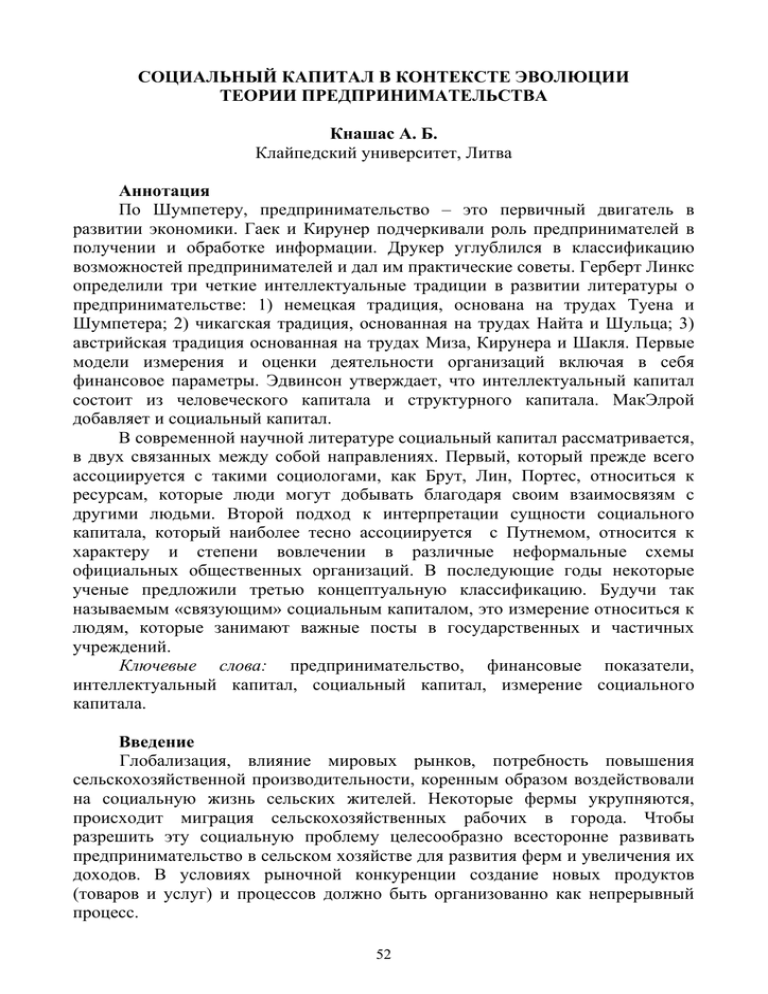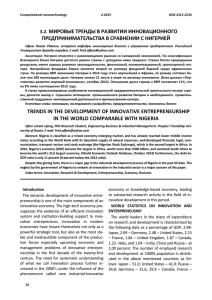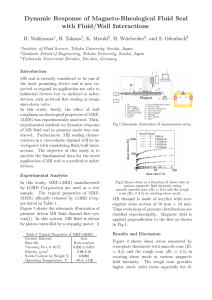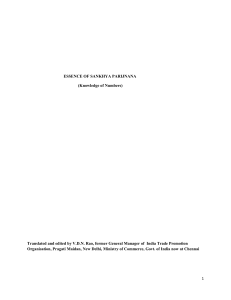СОЦИАЛЬНЫЙ КАПИТАЛ В КОНТЕКСТЕ ЭВОЛЮЦИИ ТЕОРИИ
advertisement

. . , , – . . . ; 2) : 1) , , . , . ; 3) , . . , . , , , . , , , , , . . « , » , . : , , , , . , . ( , , . , . ) . 52 . , , , , . 1980- , . . . – ( 1.1.17): “ 68, , , , ” (Pyysiainen, 2006). – / / , – , – , – , . : . . . . , / . - – , , , , . “ 1734 ., ” ”. Cantillon . Cantillon “entreprendre”, . “ , , 53 , , . . , . Cantillon , , , Say Cantillon , 2004; Sadler, 2001; Devi, 2006). , “ ” Schumpeter . 1934 . Schumpeter . Mill Schumpeter . 1911 . , 1948 ., (Rasila, “ , , “ , , ” (Schram, 2005; Rasila, 2004; Devi, 2006). Knight 1921 . , ” , (Schram, 2005). Knight , . Knight, (Klein, 2006). Hayek 1945 . “ ” , , (Schram, 2005). Kirzner 1973 . “ ” , , (Schram, 2005). Hayek . – . Hayek Kirzner , , (Devi, 2006). Drucker 1985 . “ – ” , (Schram, 2005). Herbert Link Thuene 3. Schumpeter. 2. , 1920- : ( Kirzner , 1989 . (Audretch, 2002). : 1. , Von , Knight Schultz. von Mises, Kirzner Shackle. : . . Du Pon Model); 54 ( . ROI); Cash Flow); 1970- ( ( ( CFROI). , . 1990- – : . Balanced . TSR); ( . EPS); ( . P/E); 1980: ( . M/B); ( . ROE); ( . ( . EVA); , ( . EBIDA); ( . MVA); Scorecard – BSC); (Knašas, 2004). BSC (Epstein, 1998; Martinsons, ; 2) ; . , . : , , , , 1999): 1) 3) ; 4) 1980Edvinsson (Edvinsson, 1998) 1. – . 2. , – , , , . , . McElroy Edvinsson ; ( ; ). (McElroy, 2001). . Burt, Lin, Portes. , Putn m , . “ ” , (Grootaert, 2004). Florin, J. . (Florin, 2003), Jacobs , , 1961 . . , . Seibert, S. E. . . (Seibert, 2001), , 55 , , , , Oh , , . (Daft, 2004). ” , , “ ( Liao . , , Welsh , ) (Oh, 2004). , . – , (Liao, 2005). - . . Bjornskov Swendsen , meso, macro) (Bjornskov, 2004). 2) 4) 6) ; 3) . micro, ( . – LSMS), / , Grotatert, C. (Grootaert, 2004): 1) ). . SC – IQ). ( ( ( , . , , , ; 5) ., ; ; ; . 1. 2. ( . , ., ). : ) ; ) ) 56 , ; ) ; ) , ; ; ) . 1. Audretch, D. B. (2002). Entrepreneurship: A Survey of the Literature. Institute for Development Strategies, Indiana University & Centre for Economic Policy research (CERP), London. – http://europa.eu.int/comm/entrepreneurship/ green_ paper/literature_ survey_2002.pdf 2. Bjornskov, C., Swendsen, G. T. (2004). Measuring social capital – Is there a single underlying explanation? Department of Economics Aarhus School of Business. http://www.hha.dk/nat/WPER/03-5_gts.pdf 3. Daft, R. L. (2004). Organization Theory and Design. Vanderbilt University. 4. Devi, S., Thangamuthu, C. A. (2006). New Paradigm of Entrepreneurship visà-vis Liberalization and Globalization. Global Business Review, 7:2. http://gbr.sagepub.com/cgi/reprint/7/2/259.pdf 5. Edvinsson, L. (2004). The Intellectual Capital of Nations. Handbook on Knowledge management 1: Knowledge Matters, Chapter 8, .153–163. 6. Eliasson, G., Henrekson, M. (2004). William J.Baumol: An Entrepreneurial Economist on the Economics of Entrepreneurship. Small Business Economics 23: .1 – 7. 7. Epstein, M., Manzoni, J-F. (1998). Implementing Corporate strategy: from Tableaux de Bord to Balanced Scorecards. European Management Journal, vol.16, No.2, .190–203. 8. Florin, J., Lubatkin, M., Schultze, W. (2003). A social capital Model of HighGrowth ventures. Academy of Management Journal, vol. 46, No.3, . 374–384. 9. Grootaert, C., Narayan, D., Jones, V.N., Woolcock, M. (2004). Measuring Social capital. The World Bank. http://poverty2.forumone.com/files/ 11998_WP18-Web.pdf 10. Klein, P. G., Cook, M. L. (2004). T.W.Schultz and the Human Capital Approach to Entrepreneurship. Review of Agricultural Economics, vol.28, No.3, . 344 – 350. http://www.ssu.missouri.edu/faculty/mcook/CV/RevAgEcon06.pdf 11. Knašas A. B. (2004). Organizacij inovacini strategij k rimo problemos. Valdymo teorija: teorija ir tendencijos. psl. 134–172. Klaip da. 12. Liao, J., Welsch, H. (2005). Roles of Social Capital in Venture Creation: Key Dimensions and research Implications. Journal of Small Business management, vol. 43, No.4, . 345–362. 13. Martinsons, M., Davison R., Tse, D. (1999). The balanced scorecard: a foundation for the strategic management of information systems. Decision Support Systems, No.25, . 71–88. 14. McElroy, M. W. (2001). Social innovation capital. http://www.macrinnovation. com/images/Social-Innovation_Capital.pdf 15. Oh, H., Chung, M-H., Labianca, G. (2004). Group Social capital and Group Effectiveness: the Role of Informal Socializing Ties. Academy of Management Journal, vol.47, No.6, . 860–875. 57 16. Pyysiainen, J., Anderson, A., McElwee, G., Vesala, K. (2006). Developing the entreprenurial skills of farmers: some myth explored. International Journal of Entrepreneurial Behaviour & Research, vol. 12, No.1, . 21–39. 17. Rasila, T. (2004). A new framework for growth venturing and professional ownership. Tampere Unniversity of Technology (TUT) and University of Tampere (UTA). 18. Sadler, R. J. (2001). A framework for the emergence of entrepreneurship and innovation in education. CEET, 2001. http://www.education.monash.edu.au/ centres/ceet/docs/Conferencepapers/2001confpapersadler.pdf 19. Schram. C. J. Research: (2005). Key to Our Entrepreneurial Future. : Understanding Entrepreneurship. A research and policy report, . 4–8. <http://research.kauffman.org/cwp/ShowProperty/webCacheRepository/Docu ments/Research_Policy_Singles.pdf> 20. Seibert, S. E., Kraimer, M. L., Liden, R. C. (2001). A social capital theory of career success. Academy of Management Journal, vol. 44, No.2, . 219–237. SOCIAL CAPITAL WITHIN THE CONTEXT OF BUSINESS THEORY EVOLUTION Arimantas Bronislavas Knasas Klaipeda University, Lithuania Abstract Schumpeter approves that the entrepreneurship the primary engine in economic development. Hayek and Kirzner emphasized the role of entrepreneurs acquiring and processing information. Drucker goes deep into classification of entrepreneurial opportunities and provides practical advice to entrepreneurs. Herbert and Link have identified three distinct intellectual traditions in the development of the entrepreneurship literature: l) The German Tradition, based on von Thuenen and Schumpeter; 2) The Chicago Tradition, based on Knight and Schultz; 3) The Austrian Tradition, based on von Mises, Kirzner and Shackle. The first models of measurement and an estimation of activity of the organizations concerned financial parameters. Edvinsson argues intellectual capital consist from human capital and structural capital. McElroy adds the social capital. In the contemporary academic literature, social capital is discussed in two related ways. The first, primarily associated with sociologists Burt, Lin, and Fortes, refers to the resources that individuals are able to procure by virtue of their relationships with other people. The second approach to social capital, one most closely associated with Putnam, refers to the nature and extent of one's involvement in various informal networks and formal civic organizations. In recent years, some scholars have suggested a third conceptual classification. Called "linking" social capital, this dimension refers to one's ties to people in positions of authority, such as representatives of public and private institutions. Key words: entrepreneurship, financial indicis, intellectual capital, social capital, social capital measurement. 58


